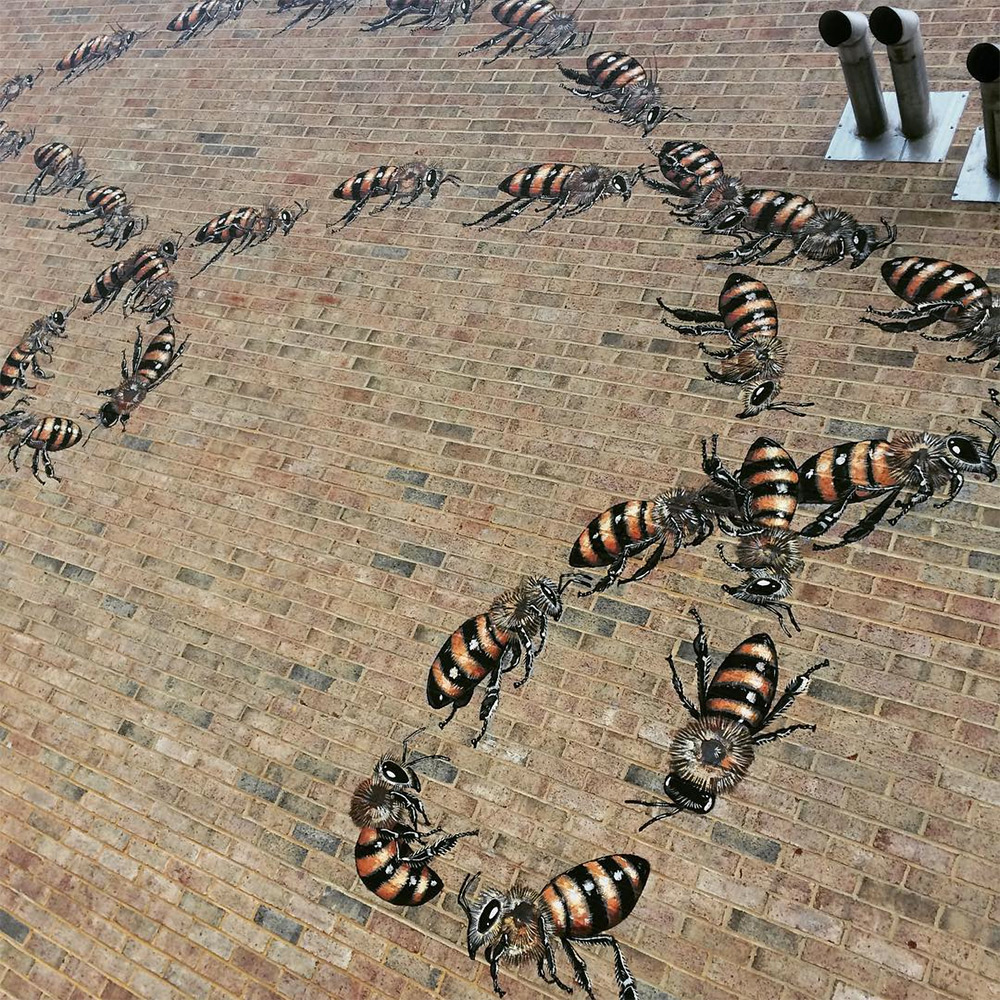New York City — Matthew Willey is a New York and Asheville, North Carolina-based artist who makes his living painting murals on the walls of homes or businesses.
He set a challenge for himself with his The Good of the Hive project: he is trying to paint 50,000 honeybees on buildings scattered across the planet. The goal is partly to raise awareness for the declining population of honeybees, which tends to get ignored, as it’s just one apocalypse scenario out of 50 on our plate right now.
Fifty thousand is a reference to the number of honeybees required to maintain one healthy colony. They’re large and realistic enough so that one can admire the ornate structure of each individual bee. They travel across the walls in graceful swarms, showing these creatures as a collective as well as individuals. The message: you’d miss them if they were gone. Indeed, seeing them illustrated like this made me realize how few I’ve seen recently.
The worldwide challenge has meaning as well. This is a global problem and without this keystone pollinator, humanity itself, not just a country or two, will suffer. Both the bees and ourselves share a common fate.
This sets us up for a communal message. It’s not much of a stretch and it’s handled with poise:
The Good of the Hive Initiative begins with the struggle of the honeybees, but it also views the hive as a metaphor for communities of people. Honeybees within the hive ‘think’ collectively; their immune system is collective: the health of the individual is based on the health of the collective. Whether that community is an actual honeybee hive or a community of human artists, kids in a school, military veterans, gay people, women with cancer, marginalized people, skateboarders, or the American people as a whole, the health and success of the individual relies heavily on the connections within the group– and consequently between the groups within the greater society.
When we connect, we thrive. This is the essence of The Good of the Hive Initiative. Matthew realized over the course of the last five years of obsessing about honeybees that his own path as an artist was more aligned to its truth when it was being channeled toward connection–connection to the honeybees, as well as to the hive in which he lives.
The sad thing about the murals (and not that this is Matt’s job to close the loop for us) is that it’s a call to action without a satisfying resolution. What can be done? This is the miserable part of most of these problems: we understand their scope and their consequences, but there’s little hope of relief. According to the National Geographic article I posted above, the EU has resolved to ban the use of one pesticide that could (we think) be the cause of the decline. You shouldn’t have to guess which other major economic power refused to do anything about it. So what’s to be done? How do you fight against a). the inertia of the public and b). the utter indifference of the people who make bank from callous, suicidal business practices? Who do you vote for? Who do you give money to? Whose factory do you visit with pitchforks and torches and when? “Awareness” seems a little weak when balanced against a global famine. That’s not Matt’s fault. I’m in the same boat, too. By the way: you should be aware that the honeybees are dying and that they’d be better off if more people cared.
There are no satisfying resolutions ahead of us, no certain ones. In this way the murals can be read like mourning instead of a call to action. It suggests that the bees, after feeding us since the dawn of humanity, can only give us a general lesson about being gentle and selfless as they disappear forever. If that sounds heartless, if that upset you, then good. Now go upset someone else.
It’s a meager way to pay them for their help, but if Matt’s only achievement is to remind people of the old normal, maybe some of us will eventually get the message and resolve to stop doing this to ourselves.
Bill Rodgers is the Managing Editor of cfile.daily.
Do you love or loathe this work of (not quite) contemporary ceramic art? Let us know in the comments.







I am President of The Oregon State Federation of Garden Clubs and we are creating a Fall Festival at The Oregon Garden in Silverton, Oregon in September. Our organization is very interested in your coming to paint a bee mural on a building wall at The Garden. Is that possible?
Gaye Stewart
Love bees. Love honey. Love your art and heart..
come paint on my bricks